Submitted by: Douglas Justice, Associate Director, Horticulture and Collections
Considering the restrictions around getting out and visiting public gardens, we thought it might be useful to highlight a few common plants that people are likely to encounter in their own neighbourhoods. We’ll be updating this feature as different plants come into bloom, for as long as access to public gardens is restricted and physical distancing recommendations continue.

Photinia x fraseri (photinia or red-tip). This ubiquitous evergreen shrub is often used for hedging, but it is most commonly seen as a filler shrub in larger residential developments (a favourite of townhouse complexes). In my neighbourhood (which is going on twenty-five years old_ it’s a frequent yard shrub, even on smaller lots, despite the fact that photinia can quickly grow to 8 m or so. But then, people love to clip, and photinia is an ideal plant in this regard—tolerating any sort of arbitrary pruning and responding at almost any but the coldest time of the year with throngs of brilliant red new growth.
The plant is a hybrid of two Photinia species, one Chinese and the other Japanese. It was discovered in 1940 by Ollie Fraser in his nursery in Birmingham, Alabama. The full name of the plant is Photinia x fraseri ‘Birmingham’, but most people just call it photinia. The name Photinia is from the Greek, photos, which means light, referring to the shining young foliage of most species. Given sufficient room (like on the highway embankments near my neighbourhood), photinias can really get going. In the absence of pruning, plants more than 5 m tall and wide are not unusual. Unpruned photinias in the open typically produce big, rounded clusters of small flowers on a few branch tips in the early summer, and these are sometimes followed by small red berries.
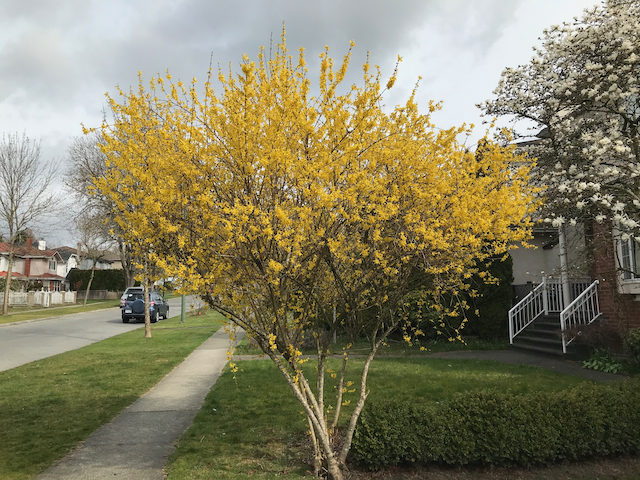

Forsythia x intermedia (border forsythia). The forsythias are exceptionally common deciduous shrubs with bright yellow, spring-borne flowers. They were named for William Forsyth, a Scottish botanist who was active in the British horticultural community in the 18th century. Border forsythia is a hybrid of two Chinese species, one with stiff, upright stems, the other with more pendent branches. The hybrid is intermediate between the parents and makes a broad haystack of a bush to 3 m tall and wide (or wider) after about a decade of growth, unless pruned, which is often the case. Unfortunately, the pruning of forsythia is often done badly, with no consideration for its natural form or the removal of flower buds.
The shrub is easy to recognize, even without its surprisingly copiously-produced, brash yellow flowers. The arching stems, which multiply at ground level, are golden brown and covered in tiny warts (they’re not actually warts, but lenticels—breathing pores). In leaf, without flowers, forsythia is seldom given a second look, appearing much like horticultural wallpaper. In autumn, however, forsythia can shine again, with leaves that turn an intense plum purple. Some people— particularly those who hail from the prairies—are as nostalgic about forsythia as they are for lilacs (they are both famously cold-tolerant shrubs), but the size and vigour of forsythias generally means that they’ll have to be pruned to keep them from overtaking valuable garden real estate. It’s worth mentioning that forsythia was the false “miracle cure” for the virus infection in the scary pandemic movie Contagion. Don’t try this at home.
Narcissus hybrids
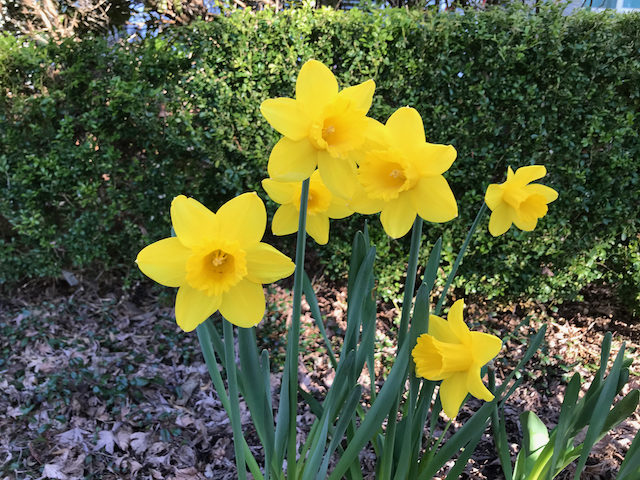
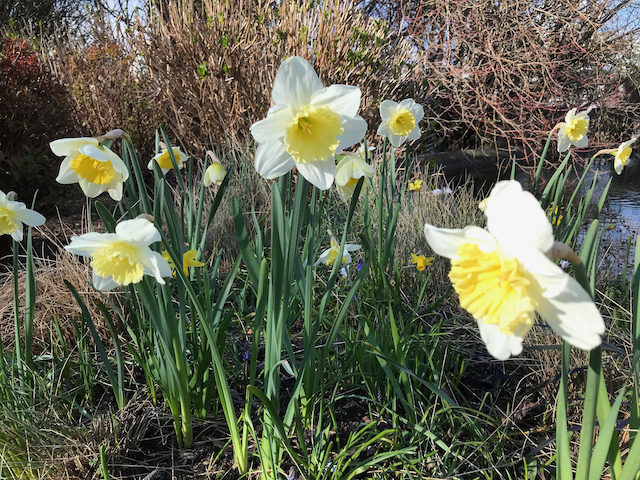
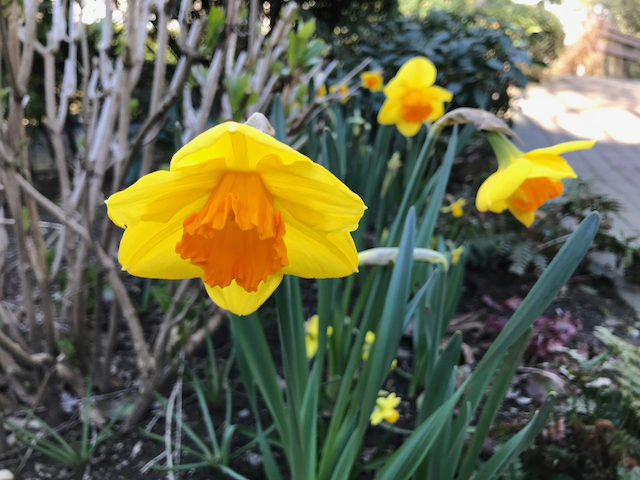
Narcissus hybrids (daffodils). Who doesn’t like daffodils? And who doesn’t recognize the distinctive trumpet-tube (known as a corona) and radiating petaloid foil (the tepals) of these fragrant, friendly, spring blooms? In Greek mythology, Narcissus was a self-loving youth who became enamoured of his own reflection in a pool of water and was turned into the flower of that name. Narcissus are bulbous plants, favouring grassy banks near ponds or streams. The Narcissus of the Greeks were modest species, but nowadays, daffodils come is a huge range of sizes and colour combinations from centuries of breeding work.
Common garden cultivars include: ‘Ice Follies’, a big flower with a pale yellow, short, frilly corona and cool white tepals, and ‘Tete-a-tete’, a cute yellow miniature with one or two flowers per stem. ‘Fortissimo’ has tall, slender stems and flowers with buttery yellow tepals and a shallow, cup-shaped orange corona, while ‘February Gold’ is a medium-sized daffodil with a perfectly balanced long-tubed, yellow corona and yellow tepals. My favourite bicoloured daffodil is ‘Jet Trail’ which is medium sized with a straight-tubed, orange corona and yellow tepals that jut slightly backwards, as if they were always facing into a strong wind.
As common and familiar as these flowers are, daffodils are poisonous. The viscous clear sap that exudes from cut stems contains alkaloids that are toxic to animals (including us), and in arrangements, poison the water for other kinds of cut flowers.
Conspicuously absent from the above list of daffodils is the most common one: the classic, large-flaring-trumpet, yellow-on-yellow, King Alfred-type. It’s the daffodil we most often see on roadsides and in the supermarket. Before the 1960s, nearly all daffodils sold were ‘King Alfred’—an English hybrid that was bred and became a sensation at the end of the 19th century. Since that time, daffodil breeders introduced many new and improved, similar-looking daffodils (e.g., Carlton, Golden Harvest and others). These newbies now account for the majority of large-yellow-daffodil sales. But the name King Alfred has better marketing mojo than any of the others, and so, you may be buying a Carlton masquerading as a King Alfred. Who was King Alfred? He was King of Wessex and King of the Anglo-Saxons in the 9th century AD. He was also known as Alfred the Great, and was famous for his military exploits and legal reforms, but also for his advocacy for education. No one knows if he liked daffodils.
Prunus cerasifera
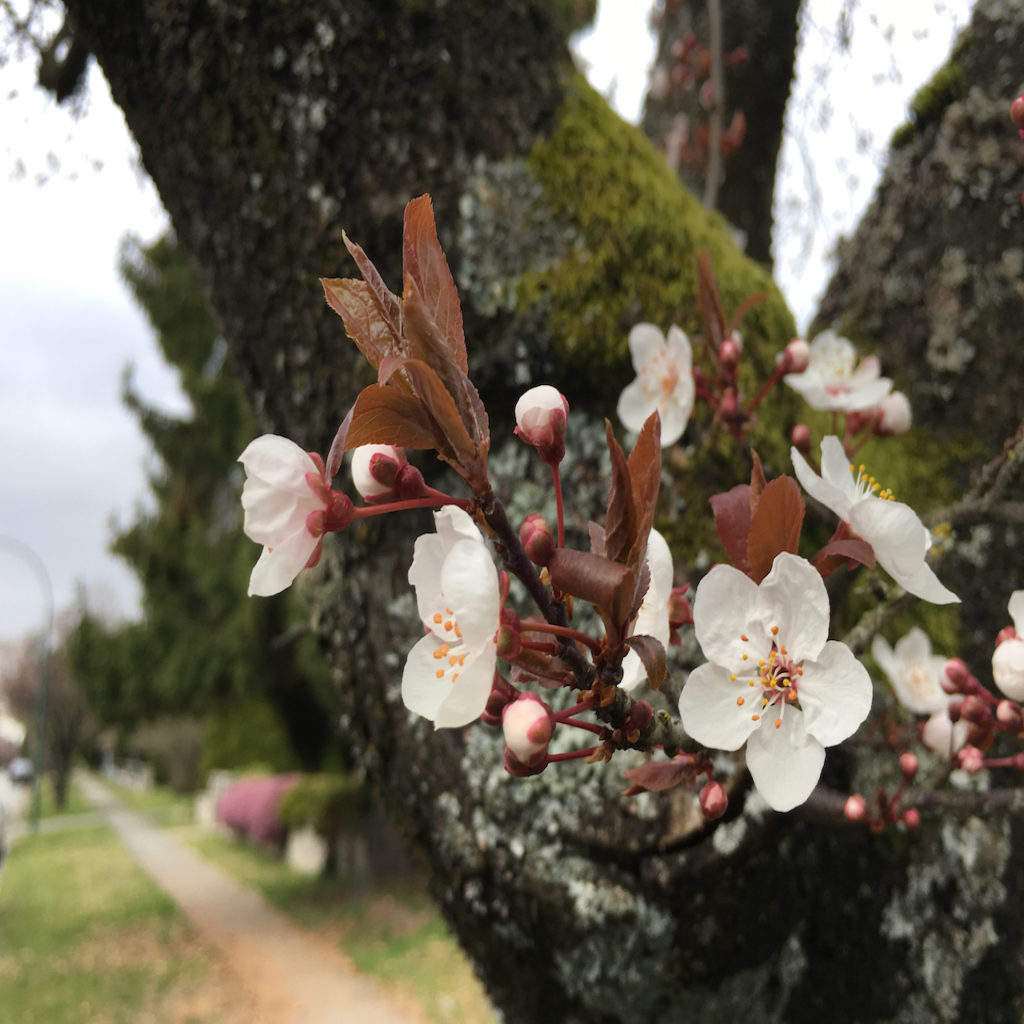
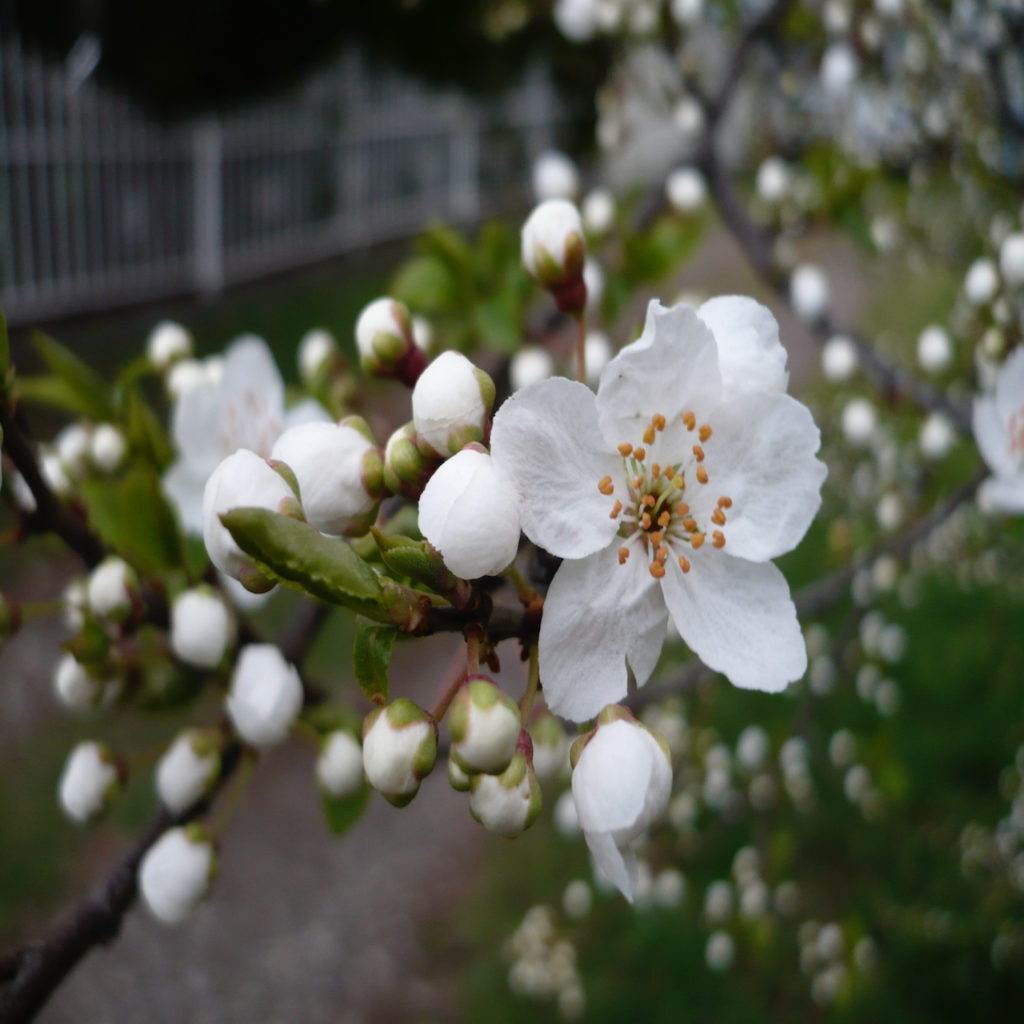
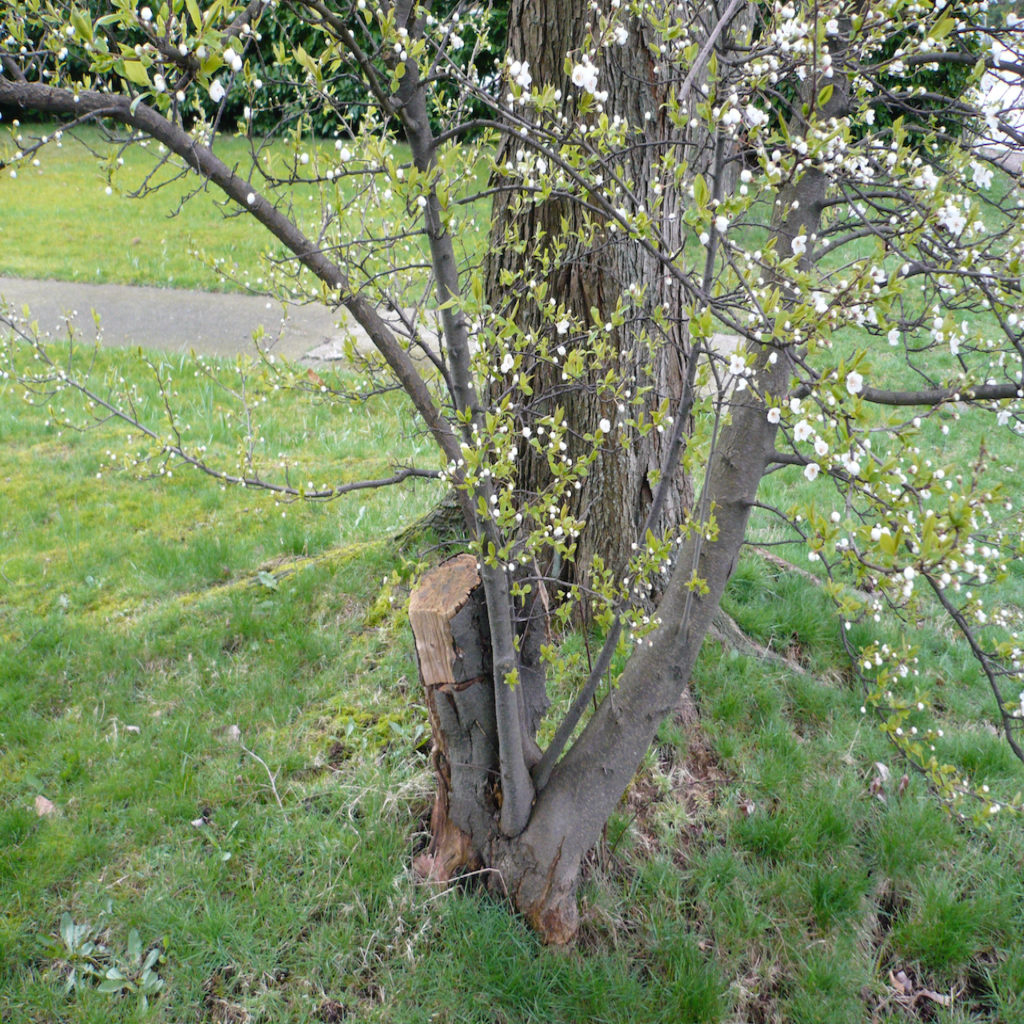
Prunus cerasifera (cherry plum, myrobalan). By far the most common plum in Vancouver, the cherry plum is a species of several guises. Most would recognize the purple-leaf plum cultivars ‘Nigra’ (white flowers), ‘Krauter Vesuvius’ (pale pink flowers) and ‘Thundercloud’ (bright pink flowers). These all start to flower around the Ides of March (the middle of March), and continue to flourish until they’re overshadowed by the flowering cherries, for which Vancouver is more famous.
Purple-leaf plums are often confused with cherries—that is, until they leaf out—but they are actually pretty easily distinguished at any time. For one, while the cherry tree typically has a spreading scaffold of branches, purple-leaf plums almost all resemble an eight-year-old’s idea of a tree: a straight stem and a densely branched rounded head, like a lollipop. The bark on the two trees is markedly different: dull and dark on the plum, and brown with lighter lines of lenticels (breathing pores) on the cherry. Plum trees also produce their flowers singly or in pairs, whereas cherries produce flowers in clusters of usually three or more, and they almost never produce a rounded head. When plums leaf out, their leaves unroll; cherries unfold their leaves. The fruits of Prunus cerasifera—the plums—are small and purple-red (like big, round cherries—the name cerasifera means “bearing cherries”) but they often go unseen, hidden in the leafy crowns of purple-leaf plums. They are delicious. Birds appear to think so too, and there are plenty of seedlings from bird-dropped seed around Vancouver. But these trees look nothing like their purple-leaved parents. In fact, a seedling in bloom looks more like a cherry than a purple-leaf plum—though a close look at the arrangement of flowers puts paid to that idea. Seedlings have arching, wildly spreading, occasionally thorny branches, green leaves and white or pale pink flowers. This may seem odd, but it more accurately describes this species as it exists in the wild. Purple leaves and well-behaved branching are rare traits in wild trees, but clearly, that’s what people want, and so here they are.
Prunus x yedoensis ‘Akebono’
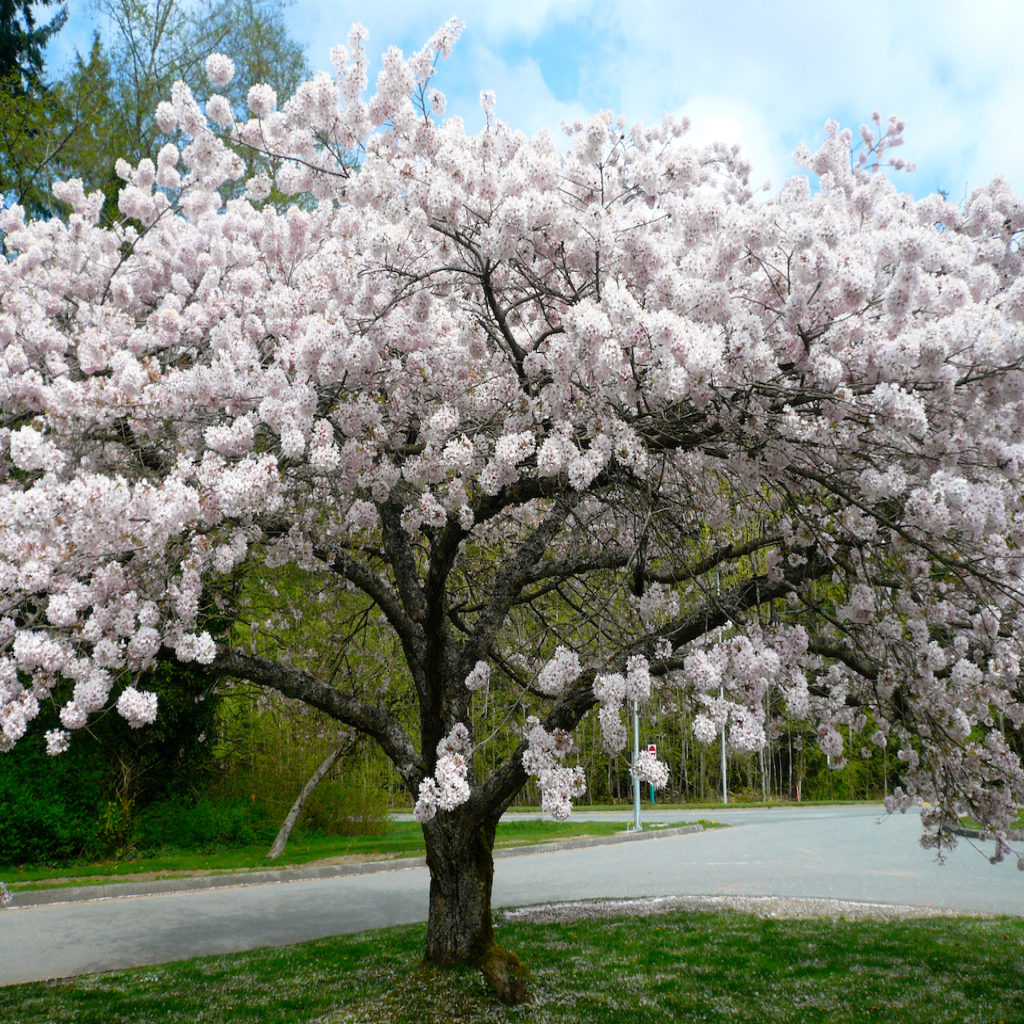

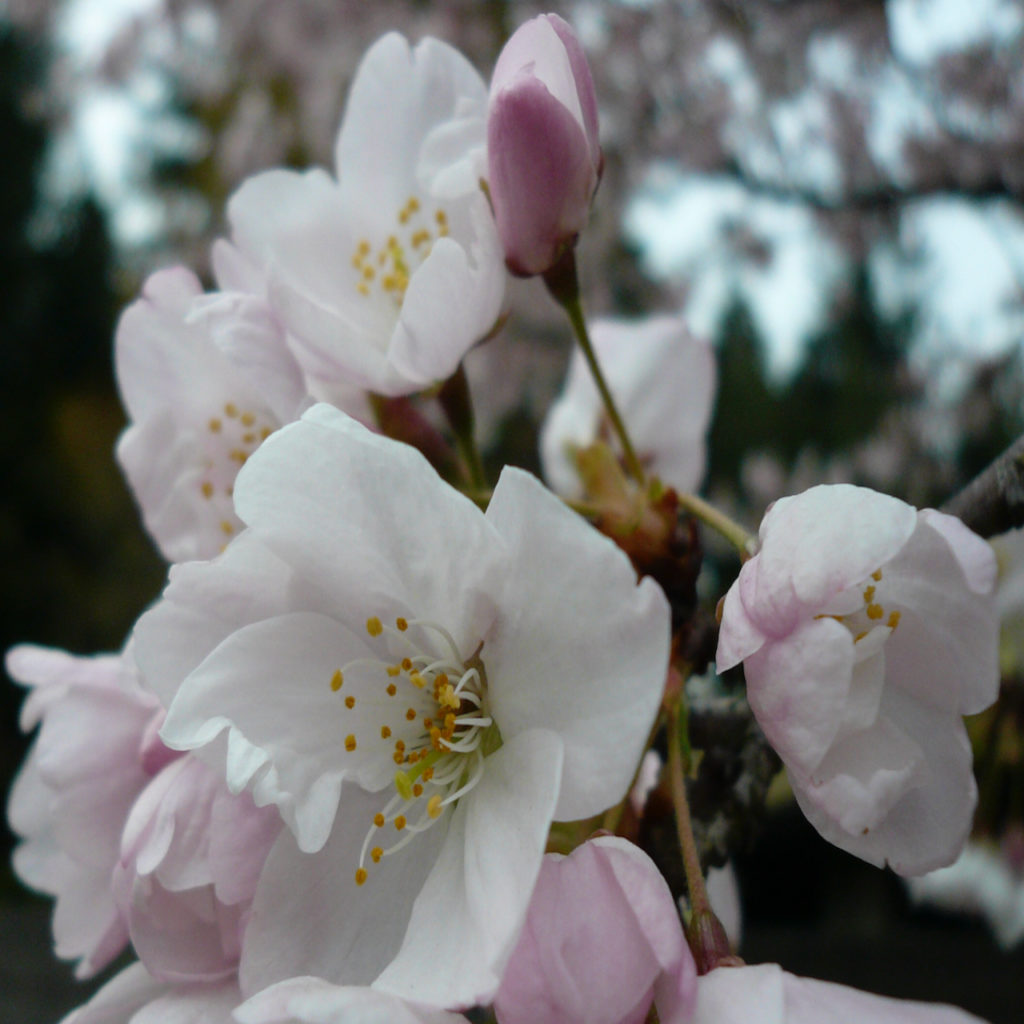
Prunus xyedoensis ‘Akebono’(daybreak cherry). In the first days of spring, daybreak cherries begin to flower. It always starts tentatively—like popping corn—two or three individual blossoms on a twig. Then with increasing speed other isolated flowers, whole twigs, and entire branches explode into enthusiastic bloom. By the time a tree is fully out, usually in the first week of April, the ground below will be dotted with the petals of the earliest flowers; another week later and the ground will be thick with tidal drifts of spent blooms. Despite its Japanese name, it is a North American invention—a seedling of the Yoshino cherry (Prunus x yedoensis ‘Somei-yoshino’), selected and named in the 1920s by a nursery in California. Daybreak cherry is exceedingly common here and among the most popular flowering cherries in commercial, street and park plantings. This is not surprising, as it is reliable in flower (even in the rain and wind) and never grows overly large. It is an instantly recognizable cherry with its masses of pink flowers and low, spreading crown (like a broad, inverted cone). In the autumn, its smallish light green leaves turn clear yellow or orange as they fall, exposing fine twigs and pointed buds.
Yoshino cherry is the cherry tree celebrated in Japan at hanami (cherry-viewing) festivals. It is ubiquitous from one end of Japan to the other, and blooms at different times depending on latitude and elevation. Flowering starts first in the south and moves in a wave toward the cooler areas to the north. Yoshino cherry is often confused with ‘Akebono’ and has many of the same qualities, except that it has only “single” five-petaled flowers (the daybreak’s are inflated by occasional extra petals). There are significant numbers of Yoshino cherry in Stanley and Queen Elizabeth Parks, on the Cambie Heritage Boulevard between 39th and 49th Avenues, and on the UBC campus, which is one of the few places where they still outnumber daybreak cherries.



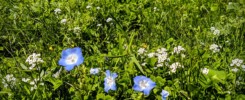
THANK YOU for this lovely feature! I look forward to your monthly updates. Arlene Stamp
Does metro Vancouver have any plans to plant food seeds for distribution to people who want to grow food this summer? Just read about how the city of Victoria has just voted to do this.
Loved the article.